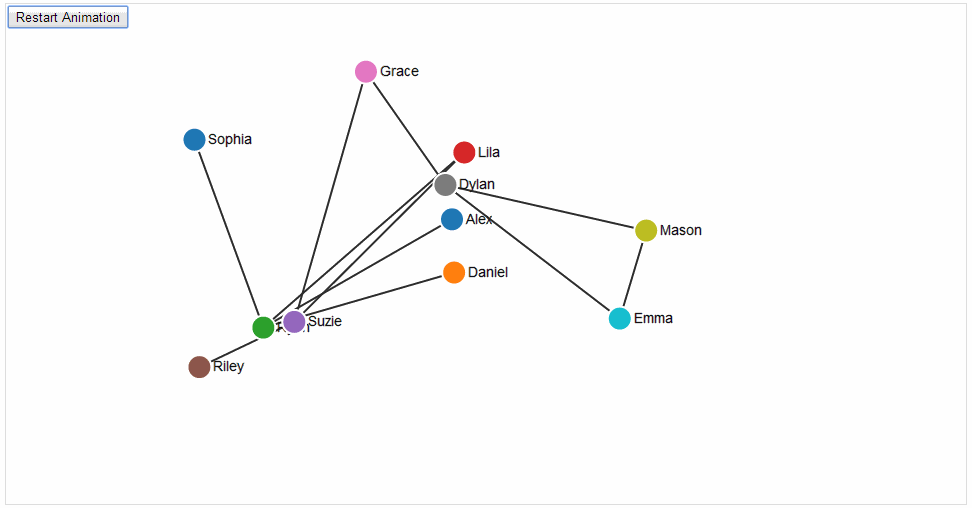I am new to D3 and working on a force directed graph where the json data is dynamic. I am able to change the force graph upon receiving new data but that happens with a springing effect. The code that creates my force graph is :
<div class="graph"></div> <script> var w = 660, h = 700, r = 10; var vis = d3.select(".graph") .append("svg:svg") .attr("width", w) .attr("height", h) .attr("pointer-events", "all") .append('svg:g') .call(d3.behavior.zoom().on("zoom", redraw)) .append('svg:g'); vis.append('svg:rect') .attr('width', w) .attr('height', h) .attr('fill', 'rgba(1,1,1,0)'); function redraw() { console.log("here", d3.event.translate, d3.event.scale); vis.attr("transform", "translate(" + d3.event.translate + ")" + " scale(" + d3.event.scale + ")"); }; var force = d3.layout.force() .gravity(.05) .charge(-200) .linkDistance( 260 ) .size([w, h]); var svg = d3.select(".text") .append("svg") .attr("width", w) .attr("height", h); d3.json(graph, function(json) { var nodeList = json.nodes; var link = vis.selectAll("line") .data(json.links) .enter() .append("line") .attr("stroke-opacity", function(d) { if(d.label == 'is a') { return '0.8'; } else { return '0.2'; }; }) .attr("stroke-width", function(d) { if(d.value !== null) { return d.value; } else { return 2; }; }) .style("stroke", function(d) { if(d.color !== null) { return d.color; }; }) .on("mouseover", function() { d3.select(this) .style("stroke", "#999999") .attr("stroke-opacity", "1.0"); }) .on("mouseout", function() { d3.select(this) .style("stroke", function(d) { if(d.color !== null) { return d.color; }; }) .attr("stroke-opacity", function(d) { if(d.label == 'is a') { return '0.8'; } else { return '0.2'; }; }) }); link.append("title") .text(function(d) { return d.label } ); var node = vis.selectAll("g.node") .data(json.nodes) .enter() .append("svg:g") .attr("class","node") .call(force.drag); node.append("svg:circle") .attr("r", function(d) { if (d.size > 0) { return 10+(d.size*2); } else { return 10; } }) .attr("id", function(d) { return "Node;"+d.id; } ) .style("fill", function(d) { if(d.style == 'filled') { return d.color; }; }) .style("stroke", function(d) { if(d.style !== 'filled') { return d.color; }; }) .style("stroke-width", "2") .on("mouseover", function() { d3.select(this).style("fill", "#999"); fade(.1); }) .on("mouseout", function(d) { if (d.style == 'filled') { d3.select(this).style("fill",d.color);fade(1); } else { d3.select(this).style("stroke",d.color); d3.select(this).style("fill","black"); } fade(1); }); node.append("title") .text(function(d) { return d.Location; } ); force.nodes(json.nodes) .links(json.links) .on("tick", tick) .alpha(1) .start(); function tick() { node.attr("cx", function(d) { return d.x; }) .attr("cy", function(d) { return d.y; }) .attr("transform", function(d) { return "translate(" + d.x + "," + d.y + ")"; }); link.attr("x1", function(d) { return d.source.x; }) .attr("y1", function(d) { return d.source.y; }) .attr("x2", function(d) { return d.target.x; }) .attr("y2", function(d) { return d.target.y; }); } }); </script> I am able to create a new graph when a new json string is received by recalling the whole function again. This creates a new graph in place of the old. I am unable to update the old graph with the new set of values as the values are received; the nodes in my graph do not change, just the relation among them changes.
I did stumble upon an example (http://bl.ocks.org/1095795) where a new node is deleted and recreated, but the implementation is a bit different.
Any pointers or help will be really appreciated.
Well I could find the solution browsing through, posting it here for anyone needing help on this topic. The idea is to create an object of the graph and playing around with the nodes and links arrays. The JS code goes as:
var graph; function myGraph(el) { // Add and remove elements on the graph object this.addNode = function (id) { nodes.push({"id":id}); update(); }; this.removeNode = function (id) { var i = 0; var n = findNode(id); while (i < links.length) { if ((links[i]['source'] == n)||(links[i]['target'] == n)) { links.splice(i,1); } else i++; } nodes.splice(findNodeIndex(id),1); update(); }; this.removeLink = function (source,target){ for(var i=0;i<links.length;i++) { if(links[i].source.id == source && links[i].target.id == target) { links.splice(i,1); break; } } update(); }; this.removeallLinks = function(){ links.splice(0,links.length); update(); }; this.removeAllNodes = function(){ nodes.splice(0,links.length); update(); }; this.addLink = function (source, target, value) { links.push({"source":findNode(source),"target":findNode(target),"value":value}); update(); }; var findNode = function(id) { for (var i in nodes) { if (nodes[i]["id"] === id) return nodes[i];}; }; var findNodeIndex = function(id) { for (var i=0;i<nodes.length;i++) { if (nodes[i].id==id){ return i; } }; }; // set up the D3 visualisation in the specified element var w = 500, h = 500; var vis = d3.select("#svgdiv") .append("svg:svg") .attr("width", w) .attr("height", h) .attr("id","svg") .attr("pointer-events", "all") .attr("viewBox","0 0 "+w+" "+h) .attr("perserveAspectRatio","xMinYMid") .append('svg:g'); var force = d3.layout.force(); var nodes = force.nodes(), links = force.links(); var update = function () { var link = vis.selectAll("line") .data(links, function(d) { return d.source.id + "-" + d.target.id; }); link.enter().append("line") .attr("id",function(d){return d.source.id + "-" + d.target.id;}) .attr("class","link"); link.append("title") .text(function(d){ return d.value; }); link.exit().remove(); var node = vis.selectAll("g.node") .data(nodes, function(d) { return d.id;}); var nodeEnter = node.enter().append("g") .attr("class", "node") .call(force.drag); nodeEnter.append("svg:circle") .attr("r", 16) .attr("id",function(d) { return "Node;"+d.id;}) .attr("class","nodeStrokeClass"); nodeEnter.append("svg:text") .attr("class","textClass") .text( function(d){return d.id;}) ; node.exit().remove(); force.on("tick", function() { node.attr("transform", function(d) { return "translate(" + d.x + "," + d.y + ")"; }); link.attr("x1", function(d) { return d.source.x; }) .attr("y1", function(d) { return d.source.y; }) .attr("x2", function(d) { return d.target.x; }) .attr("y2", function(d) { return d.target.y; }); }); // Restart the force layout. force .gravity(.05) .distance(50) .linkDistance( 50 ) .size([w, h]) .start(); }; // Make it all go update(); } function drawGraph() { graph = new myGraph("#svgdiv"); graph.addNode('A'); graph.addNode('B'); graph.addNode('C'); graph.addLink('A','B','10'); graph.addLink('A','C','8'); graph.addLink('B','C','15'); } I took Rahuls great example, made some changes, and posted a bl.ock complete with animation over time if anyone is interested in a fully functioning example. Adding/removing links/nodes really should be easier than this, but still pretty cool.
http://bl.ocks.org/ericcoopey/6c602d7cb14b25c179a4

If you love us? You can donate to us via Paypal or buy me a coffee so we can maintain and grow! Thank you!
Donate Us With